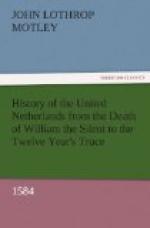The limit of the Spanish or “obedient” Provinces, on the one hand, and of the United Provinces on the other, cannot, therefore, be briefly and distinctly stated. The memorable treason—or, as it was called, the “reconciliation” of the Walloon Provinces in the year 1583-4—had placed the Provinces of Hainault, Arthois, Douay, with the flourishing cities Arran, Valenciennes, Lille, Tournay, and others—all Celtic Flanders, in short-in the grasp of Spain. Cambray was still held by the French governor, Seigneur de Balagny, who had taken advantage of the Duke of Anjou’s treachery to the States, to establish himself in an unrecognized but practical petty sovereignty, in defiance both of France and Spain; while East Flanders and South Brabant still remained a disputed territory, and the immediate field of contest. With these limitations, it may be assumed, for general purposes, that the territory of the United States was that of the modern Kingdom of the Netherlands, while the obedient Provinces occupied what is now the territory of Belgium.
Such, then, were the combatants in the great eighty years’ war for civil and religious liberty; sixteen of which had now passed away. On the one side, one of the most powerful and, populous world-empires of history, then in the zenith of its prosperity; on the other hand, a slender group of cities, governed by merchants and artisans, and planted precariously upon a meagre, unstable soil. A million and a half of souls against the autocrat of a third part of the known world. The contest seemed as desperate as the cause was certainly sacred; but it had ceased to be a local contest. For the history which is to occupy us in these volumes is not exclusively the history of Holland. It is the story of the great combat between despotism, sacerdotal and regal, and the spirit of rational human liberty. The tragedy opened in the Netherlands, and its main scenes were long enacted there; but as the ambition of Spain expanded, and as the resistance to the principle which she represented became more general, other nations were, of necessity, involved in the struggle. There came to be one country, the citizens of which were the Leaguers; and another country, whose inhabitants were Protestants. And in this lay the distinction between freedom and absolutism. The religious question swallowed all the others. There was never a period in the early history of the Dutch revolt when the Provinces would not have returned to their obedience, could they have been assured of enjoying liberty of conscience or religious peace; nor was there ever a single moment in Philip II.’s life in which he wavered in his fixed determination never to listen to such a claim. The quarrel was in its nature irreconcilable and eternal as the warfare between wrong and right; and the establishment of a comparative civil liberty in Europe and America was the result of the religious war of the sixteenth and seventeenth centuries. The struggle lasted eighty years, but the prize was worth the contest.




